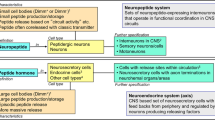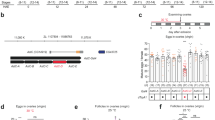Summary
-
1.
Metamorphosis in the mothManduca sexta culminates with the secretion of the peptide eclosion hormone (EH), which triggers the stereotyped behavior of adult emergence (eclosion) from the pupal cuticle. In restrained but spontaneously behaving animals, the release of EH occurred shortly before the onset of subjective night (Fig. 3) and coincided with a depletion of EH from the neurohemal organs of the brain, the corpora cardiaca-corpora allata complex (CC-CA; Fig. 4).
-
2.
EH is produced by neurons within a bilaterally paired group of brain neurosecretory cells (Group Ia) which project to the CC-CA via the nervi corporis cardiaci-1+2 (NCC-1+2; Fig. 1). Electrical stimulation of the NCC-1+2 caused a marked increase in the levels of EH secreted from isolated CC-CA (Fig. 2), while stimulation of the other nerves innervating the neurohemal organs did not.
-
3.
Electrical activity in the NCC-1+2 paralleled that of the cerebral neurosecretory cells (Fig. 1). Chronic extracellular recordings revealed a sudden increase in the tonic firing of several units within this nerve approximately 2 to 3 h before normal eclosion (Fig. 5), coincident with the release of EH bioactivity from the CC-CA (Fig. 6).
-
4.
The Group Ia neurons were electrically inactive on the day before eclosion (Day −1), but on the day of eclosion (Day 0) a subgroup of these cells exhibited both enhanced synaptic input and elevated rates of tonic firing during the normal time of EH release (Fig. 7).
-
5.
No significant differences in resting membrane potential or spike waveform characteristics were detected among the various subsets of Group Ia cells on either Day −1 or Day 0, while a significant increase in the resting input resistance was seen in the active subgroup on Day 0 (Fig. 8). This increase may be due to the regulatory effects of the steroid 20-hydroxyecdysone, which inhibits the release of EH and may act by preventing the synaptic activation of the EH neurons until the final day of adult development.
Similar content being viewed by others
Abbreviations
- AZT :
-
arbitrary Zeitgeber time
- Br :
-
brain
- CC-CA :
-
corpora cardiaca-corpora allata
- EH :
-
eclosion hormone
- NCC :
-
nervi corporis cardiaci
- SEG :
-
subesophageal ganglion
References
Bacon JP, Altman JS (1977) A silver intensification method for cobalt-filled neurons in wholemount preparations. Brain Res 138:359–363
Bell RA, Joachim FG (1976) Techniques for rearing laboratory colonies of tobacco hornworms and pink bollworms. Ann Ent Soc Am 69:365–373
Berlind A (1977) Cellular dynamics in invertebrate neurosecretory systems. Int Rev Cytol 49:171–251
Carrow GM, Calabrese RL, Williams CM (1981) Spontaneous and evoked release of prothoracicotropic hormone from multiple neurohemal organs of the tobacco hornworm. Proc Natl Acad Sci USA 78:5860–5870
Carrow GM, Calabrese RL, Williams CM (1984) Architecture and physiology of insect cerebral neurosecretory cells. J Neurosci 4:1034–1044
Chesnoy-Marchais D (1983) Characterization of a chloride conductance activated by hyperpolarization inAplysia neurones. J Physiol 342:277–308
Conner JA (1985) Neural pacemakers and rhythmicity. Annu Rev Physiol 47:17–28
Cook DJ, Milligan JV (1972) Electrophysiology and histology of the medial neurosecretory cells in adult male cockroaches,Periplaneta americana. J Insect Physiol 18:1197–1214
Copenhaver PF, Truman JW (1982) The role of eclosion hormone in the larval ecdyses ofManduca sexta. J Insect Physiol 28:695–701
Copenhaver PF, Truman JW (1986a) Identification of the cerebral neurosecretory cells that contain eclosion hormone in the mothManduca sexta. J Neurosci (in press)
Copenhaver PF, Truman JW (1986b) Metamorphosis of the cerebral neuroendocrine system in the mothManduca sexta. J Comp Neurol (in press)
Dufy B, Partouche C, Poulain D, Dufy-Barbe L, Vincent JD (1976) Effects of estrogen on the electrical activity of identified and unidentified hypothalamic units. Neuroendocrinology 22:38–47
Dufy B, Vincent J-D, Fleury H, DuPasquer P, Gourdji D, Tixier-Vidal A (1979) Membrane effects of thyrotropin-releasing hormone and estrogen by intracellular recording from pituitary cells. Science 204:509–511
Greenberg MJ, Price DA (1983) Invertebrate neuropeptides: native and naturalized. Annu Rev Physiol 45:271–288
Gunnet JW, Freeman ME (1983) The mating-induced release of prolactin: a unique neuroendocrine response. Endocrine Rev 4:44–61
Jansen RF, Bos NPA (1984) An identified neuron modulating the activity of the ovulation hormone producing caudo-dorsal cells of the pond snailLymnaea stagnalis. J Neurobiol 15:161–167
Kaczmarek LK, Jennings KR, Strumwasser F (1982) An early sodium and a late calcium phase in the afterdischarge of peptide-secreting neurons ofAplysia. Brain Res 238:105–115
Kaczmarek LK, Strong JA, DeRiemer SA (1985) Biochemical mechanisms that modulate potassium and calcium currents in peptidergic neurons. In: Kobayashi H, Bern HA, Urano A (eds) Neurosecretion and the biology of neuropeptides. Springer, Berlin Heidelberg New York Tokyo, pp 80–87
Kater SB (1968) Cardioaccelerator release inPeriplaneta americana (L.). Science 160:765–767
Kits KS, Bos NPA (1981) Pacemaking mechanism of the afterdischarge of the ovulation hormone-producing caudo-dorsal cells in the gastropod mollusc,Lymnaea stagnalis. J Neurobiol 12:425–439
Levine RB, Truman JW (1985) Dendritic reorganization of abdominal motoneurons during metamorphosis of the moth,Manduca sexta. J Neurosci 5:2424–2431
Maurer RA (1982) Regulation of prolactin gene expression. In: Conn PM (ed) Cellular regulation of secretion and release. Academic Press, New York, pp 267–300
Meech RW (1979) Membrane potential oscillations in molluscan ‘burster’ neurons. J Exp Biol 81:93–112
Miyazaki S-I (1980) The ionic mechanism of action potentials in neurosecretory cells and non-neurosecretory cells of the silkworm. J Comp Physiol 140:43–52
Moody WJ (1981) The ionic mechanism of intracellular pH regulation in crayfish neurons. J Physiol 316:293–308
Moody WJ, Bosma MM (1985) Hormone-induced loss of surface membrane during maturation of starfish oocytes: differential effects on potassium and calcium channels. Dev Biol (in press)
Nicholson S, Lin J-H, Mahmond S, Cambell E, Gilham B, Jones M (1985) Diurnal variations in responsiveness of the hypothalamo-pituitary-adrenocortical axis of the rat. Neuroendocrinology 40:217–224
Nijhout HF (1975) Axonal pathways in the brain-retrocerebral neuroendocrine complex ofManduca sexta. Int J Insect Morphol Embryol 4:529–538
Orchard I (1983) Neurosecretion: morphology and physiology. In: Gainer RGH, Laufer H (eds) Endocrinology of insects. Alan Liss Inc, New York, pp 13–38
Orchard I, Friedel T, Loughton BG (1981) Release of neurosecretory protein from the corpora cardiaca ofLocusta migratoria induced by high potassium saline and compound action potentials. J Insect Physiol 27:297–304
O'Shea M, Schaffer M (1985) Neuropeptide function: the invertebrate contribution. Annu Rev Neurosci 8:171–198
Ozawa S (1981) Biphasic effect of thyrotropin-releasing hormone on membrane potassium permeability in rat clonal pituitary cells. Brain Res 209:240–244
Pittendrigh CS (1965) On the mechanisms of the entrainment of a circadian rhythm by light cycles. In: Aschoff J (ed) Circadian clocks. North Holland, Amsterdam, pp 277–297
Poulain DA, Wakerley JB, Dyball REJ (1977) Electrophysiological differentiation of oxytocin and vasopressin-secreting neurones. Proc R Soc Lond B 196:367–384
Reynolds SE (1980) Integration of behavior and physiology in ecdysis. Adv Insect Physiol 15:475–595
Reynolds SE, Taghert PH, Truman JW (1979) Eclosion hormone and bursicon titers and the onset of hormonal responsiveness during the last day of adult development inManduca sexta (L.). J Exp Biol 78:77–86
Ruegg RP, Orchard I, Davey KG (1982) 20-hydroxyecdysone as a modulator of electrical activity in neurosecretory cells ofRhodnius prolixus. J Insect Physiol 28:243–248
Savoy-Moore RT, Schwartz NB (1980) Differential control of FSH and LH secretion. Int Rev Physiol 22:207–248
Schlichter LC (1983) A role for action potentials in maturingRana pipiens oocytes. Dev Biol 98:60–69
Schwartz LM, Truman JW (1983) Hormonal control of rates of metamorphic development in the tobacco hornwormManduca sexta. Dev Biol 99:103–114
Sokal RR, Rohlf FJ (1969) Biometry. Freeman & Co, San Francisco
Taglietti V, Tanzi F, Romero R, Simoncini L (1984) Maturation involves suppression of voltage-gated currents in the frog oocyte. J Cell Physiol 121:576–588
Truman JW (1978) Hormonal release of stereotyped motor programmes from the isolated nervous system of theCecropia silkmoth. J Exp Biol 74:151–173
Truman JW (1980) Eclosion hormone: its role in coordinating ecdysial events in insects. In: Locke M, Smith DS (eds) Insect biology in the future. Academic Press, New York, pp 385–401
Truman JW, Rountree DB, Reiss SE, Schwartz LM (1983) Ecdysteroids regulate the release and action of eclosion hormone in the tobacco hornworm,Manduca sexta. J Insect Physiol 29:895–900
Truman JW, Taghert PH, Copenhaver PF, Tublitz NJ, Schwartz LM (1981) Eclosion hormone may control all ecdyses in insects. Nature 291:70–71
Tublitz NJ, Truman JW (1985) Insect cardioactive peptides III. Identification of the cardioacceleratory peptides (CAPs)-containing neurons in the ventral nerve cord of the tobacco hawkmothManduca sexta. J Exp Biol 116:395–410
Vaughan-Jones RD (1979) Regulation of chloride in quiescent sheep-heart Purkinje fibers studied using intracellular chloride and pH-sensitive electrodes. J Physiol 295:111–137
Williams CMA (1959) The juvenile hormone I. Endocrine activity of the corpora allata of the adultCecropia silkworm. Biol Bull 116:323–338
York DH, Baker FL, Kraicer K (1973) Electrical changes induced in rat adenohypophysial cells, in vivo, with hypothalamic extract. Neuroendocrinology 11:212–228
Author information
Authors and Affiliations
Rights and permissions
About this article
Cite this article
Copenhaver, P.F., Truman, J.W. Control of neurosecretion in the mothManduca sexta: Physiological regulation of the eclosion hormone cells. J. Comp. Physiol. 158, 445–455 (1986). https://doi.org/10.1007/BF00603791
Accepted:
Issue Date:
DOI: https://doi.org/10.1007/BF00603791




